

Royal Trains
The Historical Interest of Special Transport Provided for Royalty
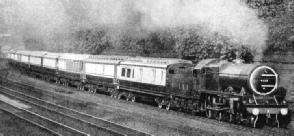
THE ROYAL TRAIN hauled by a Royal Scot, LMS locomotive. The privilege of driving the King and the Queen is not confined to any one man, but is shared by a number of veteran drivers.
BEFORE the royal train used by the King and the Queen begins its journey there are many arrangements to be made, the time-
When particulars have been received stating the exact number of persons who are to travel, the marshalling of the train is decided on. A diagram is made out showing what vehicles are to be used and which is to be the leading end of each vehicle. On this diagram is the length over buffers of each vehicle, the total length of the train and the distance from the front of the train to the King’s doorway. This last information shows the locomotive department where the engine is to stop, and the engineering department where to lay the red carpet. The weight of each individual coach and the total weight of the train have to be shown so that suitable engines for the load can be selected. The diagram depicts the passengers and the seats they are to occupy. When the diagram is finally approved a copy of it is sent to Buckingham Palace.
One particular royal train is historic. During certain periods of the Great War it was the travelling workshop and home of the King and the Queen. In some quiet branch station where it stopped for the night in those days of alarm, the royal party rested. The sentiments of the King and the Queen towards it are well known. Some years ago it was proposed to paint the train in the livery of the London, Midland and Scottish Railway, but at the request of the King the old chocolate and white was retained.
In addition to paying first-
The cost of the return journey from London to Ballater has been estimated as £450 each way. When Sir William Harcourt was Home Secretary in the ‘eighties he told a friend that Queen Victoria spent no less than £5,000 on a return journey from London to Balmoral. Look-
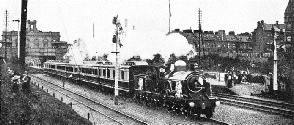
THE ROYAL SPECIAL that carried Queen Victoria from Windsor to London for the 1897 Jubilee.
Traffic arrangements for the safety of the royal train are comprehensive. Before the train is due all level crossing gates are locked; half an hour before the train enters a siding all shunting is stopped, and goods trains in sidings examined to ensure that nothing has shifted and everything is clear. The royal train is signalled mile by mile, by lamp or flag, according to the hour, for the whole journey. Four sharp rings, repeated three times, is the signal-
With the exception of one year, the Court has always made the journey to and from Scotland by train. In 1910, however, the King and the Queen decided to return to London by road, as a railway strike had occurred, and the King did not wish to embarrass the railway traffic staff.
The royal train used by the King and the Queen on their annual visit to Balmoral Castle and when they wish to make a journey involving night travel is the property of the London, Midland and Scottish Railway. Although other companies have royal trains, this one is the best known. The vehicles are kept at Wolverton, and number about twenty, the number used varying according to the particular journey. The two royal saloons, which are furnished and decorated in accordance with the wishes of the King and the Queen, have not only carried the royal passengers for many thousands of miles, but have also served during the war of 1914-
The two saloons were built for the use of King Edward and Queen Alexandra, as Queen Victoria’s saloon had become obsolete. All the vehicles are painted in the old London and North Western colours, chocolate lower and cream upper panels, with the fine lining in gold leaf.
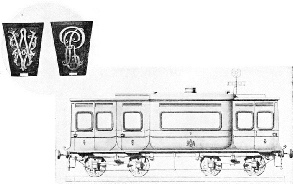
A DISK AND CROSSBAR signal was fitted to the second (GWR) royal saloon, used by Queen Victoria. This signal, which can be seen on the top of the coach, enabled Her Majesty’s wishes to be conveyed to the officer in charge of the train.
The two monograms (shown top left) are those of Queen Victoria and the Prince Consort (left) and of King Edward (right).
The royal train generally consists of about ten vehicles. It is approximately 630 ft long, excluding the engine and tender, and weighs about 370 tons. Next to the engine is a corridor brake coach with two first-
About six members of the carriage and wagon department staff act as train attendants.
The first vehicle on the train is the mess-
The exteriors of the two royal saloons are different from the rest of the train. The colours are the same, but the cornice moulding is carved with an oak leaf design and gilded. The head-
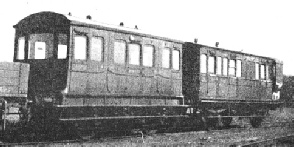
THESE TWO PICTURES show the London and South Western Railway Company’s royal saloon. This was built in 1848 for carrying Queen Victoria between Windsor and Osborne. It was subsequently used as a special first-
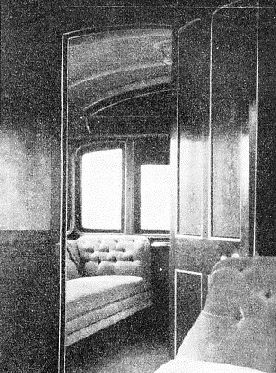
In place of the ordinary step-
The day compartment is next to the smoking-
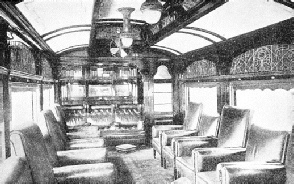
THE INTERIOR of one of the coaches on a train used by the Duke of Gloucester during his Australasian tour in 1934-
Beyond the bathroom is the last compartment in the King’s saloon, which is reserved for the sergeant footman who attends the King. The “master” switches for the electric lighting, heating and fans are in this compartment, which is furnished with an arm-
The Queen’s saloon is similar in outside appearance to that used by the King but has a different interior plan. The colour scheme is in blue. The entrance vestibule is the same as the entrance to the King’s saloon, and the two saloons are gangwayed together so as to have the two vestibules adjoining.
The vestibule leads into the Queen’s day apartment, which has two writing desks. Everything is balanced in pairs. The reason for this “balancing” is that the saloon was originally designed for Queen Alexandra, who was always accompanied by Princess Victoria. The chairs at the writing-
Adjoining the Queen’s day apartment are the dresser’s apartment and the Queen’s bedroom. Formerly there was one large bedroom with a bed at either end, one for Queen Alexandra and one for Princess Victoria. The present Queen had the bedroom partitioned off to form a smaller bedroom for her maid, or dresser, as she is styled. The furniture is covered in blue silk brocade with a design of pagodas and little Chinese figures sprinkled over it. The Queen’s bathroom, which adjoins, has a rose-
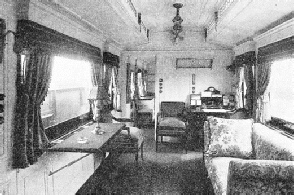
THE KING’S SITTING-
The royal dining-
Travelling Telephone Exchange
The saloon for the royal suite is next to the dining-
The large saloon is really an office where the King’s correspondence is attended to. In each compartment of the King’s saloon is a bell-
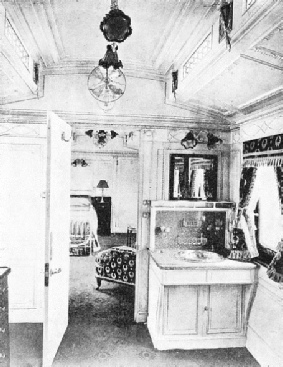
ANOTHER VIEW of the LMS royal train, showing the King’s dressing room.
The last vehicle of the royal train is another brake van similar to the leading one. It contains the electrical equipment for heating the royal saloons, and also the bedding and the royal luggage. The guard who is accompanying the train travels in this vehicle. As it is not convenient for the train staff to travel through the royal saloons, telephones are fitted throughout the train so that the train staff in the front of the train can communicate with their colleagues at the back.
The Southern Railway royal train, which the King uses for the journey to Portsmouth, where he embarks in the Royal Yacht, Victoria and Albert, for his holiday during Cowes Week, has associations with the Royal Navy, and has carried the King on a number of occasions when he has reviewed the Fleet.
When HMS Victory was afloat in Portsmouth Harbour she began to fire her royal salute of twenty-
The Southern Railway’s royal train generally consists of the following vehicles, after the engine: 1. Saloon brake. 2. First-
Almost every head of a foreign State visiting England lands at Dover and travels over the Southern line to Victoria. Pullman coaches are used for their conveyance. Distinguished foreign visitors from countries troubled by political disturbances have to be carefully protected. Sometimes tact is needed, as on the occasion when the former Shah of Persia summoned the railway officials before him and demanded the instant decapitation of the engine-
In Queen Victoria’s days the London Brighton and South Coast Railway, in the effort to be immaculate, used to whitewash the whole of the coals on the top layer on the tender of the engine of the royal train, and to put the Royal Arms below the chimney of the engine.
Royal saloons are frequently attached to ordinary trains. During the holiday of the King and the Queen at Eastbourne in 1935, the Southern Railway royal saloon, for instance, was attached to an ordinary train when the Queen wished to visit London. When foreign visitors of importance arrive in England the saloon is attached at Dover to the boat express but is detached at Herne Hill Station and drawn by another locomotive to a reserved platform at Victoria, where British State officials, reporters and photographers and news-
The “Honeymoon Train”
The Great Western Railway provided the “Honeymoon Train” which carried the Duke and Duchess of Kent from Paddington to Birmingham on Thursday, November, 29, 1934. The formation of the train was: Locomotive No. 6000, “King George V”; Seventy-
The coupé saloon, “King George V”, was one of eight designed and built at Swindon, and named, by permission of the King, after members of the Royal Family. The names of the other seven are “Queen Mary”, “Prince of Wales”, “Duke of York”, “Duke of Gloucester”, “Duchess of York”, “Princess Mary”, and “Princess Elizabeth”. These saloons arc 60 ft long and 9 ft 7 in wide, as are those of the Cornish Riviera Express -

THE QUEEN’S SALOON is decorated in white enamel. This gives a yacht-
For the “Honeymoon Train” the interior was decorated in autumn tints, the various shades of brown giving an atmosphere of warmth and comfort. The chairs, of the wing type with loose cushions, were upholstered in brown-
Queen Victoria insisted on a speed limit of forty miles an hour, but when King Edward came to the throne the Great Western were able to show what they could do. The first non-
Both journeys were made to schedule without any attempt at specially fast running. This was before the opening of the Westbury “cut-
All Records Broken
This speed was, however, exceeded by the train that carried the then Prince and Princess of Wales, the present King and Queen, from Paddington to Plymouth on July 14, 1903, when the time for the run was cut to three hours fifty-
The first royal saloon was built by the Great Western. It was ready in July, 1840, a newspaper account of the vehicle being:
“The Great Western Railway Company, anticipating the Patronage of the Queen and her illustrious Consort, Prince Albert, and of the Members of the Royal Family, have just had built a splendid royal carriage for their accommodation. It is a very handsome vehicle, 21 ft in length and divided into three compartments, the two end ones being 4 ft 6 in long and 9 ft wide, while the centre forms a noble saloon, 12 ft long, 9 ft wide, and 6 ft 6 in high. The exterior is painted of the same brown colour as the others of the Company’s carriages, and at each end is a large window affording a view of the whole of the line. The interior has been most magnificently fitted up by Mr. Webb. The saloon is handsomely arranged with hanging sofas of carved wood in the rich style of Louis XIV, and the walls are panelled out in the same elegant manner, and fitted up with rich crimson and white silk and exquisitely executed paintings representing the four elements by Paris. The end comp-
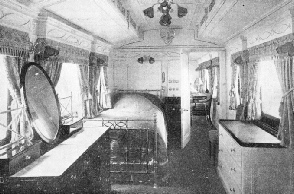
A SILVER-
The carriage was built by David Davies, of London, and appears to have been similar to posting carriages with the body inside the wheels. In its original condition it was probably used only by Queen Adelaide and Prince Albert, as a minute of the general traffic committee records that the Queen’s carriage was likely to be required for a journey by the King of Prussia, and that it needed improvements, being less easy and not so safe on four wheels as the first-
Queen Victoria was not the first royal person nor the first queen to travel by train in England. On November 14, 1839, Prince Albert, then the Queen’s suitor, accompanied by his elder brother, took the train from Slough to Paddington, after he had visited the Queen at Windsor Castle. After his marriage in the following year he travelled frequently by train. The first “Queen’s carriage” was used on August 15, 1840, by the Dowager Queen Adelaide (widow of William IV), from Wallington Road to Slough. The King of Prussia, who had arrived at Windsor for the christening of the Prince of Wales, travelled to London from Slough by the railway on January 24, 1842.
Queen Victoria decided to make the journey by rail, and the company was notified of her decision. Before noon on June 13, 1842, the royal train was waiting in Slough Station. The Queen arrived, examined the royal saloon and the line, made searching inquiries into the whole of the arrangements, and then entered her saloon. The famous Gooch, the superintendent of the locomotive department, and the still more famous Brunel, were responsible for the engine, although it is doubtful if Brunel drove it; more probably Gooch did. Precisely at noon the train started.
More than an hour before, Paddington was the scene of a great animation. A crimson carpet was laid from one end of the platform to the other. Elegantly dressed ladies (wives, daughters and friends of the directors) were agog with excitement. A detachment of the 8th Royal Hussars arrived. At twenty-
Mishaps to Royal Trains
The Queen was so pleased that on July 23, when she returned to Slough (for Windsor) with Prince Albert, she had with her the Princess Royal, and also the eight-
The second GWR royal saloon, built in 1848, had a disk-
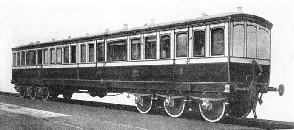
A SPEED LIMIT of forty miles an hour was insisted on by Queen Victoria when she travelled by train. This picture shows another of the saloons used by Her Majesty.
This idea of a special signal was used on other royal saloons. One in use on the London and North Western Railway comprised a dial and lever, by which the signal to go slow or to stop could be given by the officer in the saloon. The look-
In 1855, when the Queen and Prince Albert were returning from Scotland to London, the axles of one of the carriage trucks ran hot, and the vehicle was detached at Forfar; farther south, at Kirkliston, one of the steam-
Queen Victoria’s early journeys were excellent advertisements for the safety of the railways. In September, 1848, when the Queen and Prince Albert were aboard the Royal Yacht at Aberdeen, fog prevented the vessel from putting to sea, and it was decided to return to London by railway. In those days there was no through service from Aberdeen, nor was the telegraph extended sufficiently to enable the railway to use it to arrange for the special train. Soon after noon, on the Friday, September 29, word was sent to Mr. Errington, Engineer of the Aberdeen Railway, then in course of construction, who was in Aberdeen, that the Queen had decided to return by land. Mr. Ker, the assistant engineer, sent by coach to Montrose, the extreme northern point to which the railway was open to the south. From Montrose to Perth arrangements were made only half an hour before the Queen arrived, on a wet and foggy night. Owing to a blunder in single line working, there was a narrow escape of trouble between Forfar and Glamis, but the Queen was carried safely to London, and the “Railway Chronicle”, of October 8, 1848, announced:
“Between London and Aberdeen there were no fewer than six railways associated with the London and North Western. . . . When it is known that Her Majesty was conveyed over a distance of 500 miles, at the rate of 35 miles an hour, including stoppages, at a rate amounting to but not exceeding at any time fifty miles an hour over a country rising twice to an elevation of 1,000 ft above the level of the sea, and descending at intermediate stations nearly to the level of the sea, and so conveyed without the slightest alarm or cause for danger, we may be permitted to say that the railways of England, under their present system of management, have reached an amount of perfection, regularity, and security unsurpassable and almost unhoped for”.
When Queen Victoria travelled to Scotland in 1850, all the London and North Western signalmen along the line were ordered to wear white gloves and salute the train as it passed, From the days of Fenian threats the lines were watched and patrolled with special care. A pilot engine was sent fifteen minutes ahead of the royal train, and no train was allowed to move until fifteen minutes after the royal train had passed All trains travelling in the opposite direction had to stop, and shunting was stopped over lines and sidings.
Royal waiting-

AN INTERESTING COMPARISON with the picture above is made by this photograph of the two LMS royal saloons used by the present King and Queen. The door handles are gold-
Mr. Daniel Gooch, afterwards created a baronet, was proud of his connexion with the royal train. He wrote in his diary: “While I had the office of locomotive-
The Queen thought, too, of the efforts of the railway officers on her behalf. In 1892 she heard that Mr. G. P. Neele, the superintendent of the London and North Western Railway Company, had completed his hundredth journey in charge of the royal train. She presented him with an elegant, massive chiming clock bearing a suitable inscription on a tablet beneath the dial.
You can read more on
“The London & North Western Railway”
and
and
on this website.